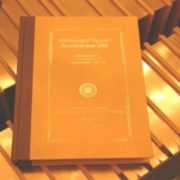Knowing, Understanding and Realization
Knowing, Understanding and Realization
In this age of knowledge, we come across an abundance of knowledge. We create knowledge and abandon knowledge when someone creates or finds new knowledge. Consider the knowledge about food we eat. Few decades ago, based on the then prevailing knowledge, US government constructed a food pyramid. Recently, after researchers generated new knowledge regarding the foods, and their nutritional values, the previous food pyramid changed because the new knowledge caused abandonment of some of the previous knowledge. We can find these shifts in knowledge in all areas such as medicine, psychology, physics, and chemistry (to name a few). Buddha Dhamma is going beyond mere knowledge. To gain benefits from this Dhamma just knowing is inadequate. Just knowing the dependent-origination or four Noble Truths is inadequate. It is necessary to understand it and then it is necessary to achieve a realization.
Buddha Dhamma or Buddha’s teachings have survived through thousands of years due to inherent truths that reveals the true nature of existences and the world. The essence of the Buddha’s teachings is in the Four Noble Truths. The Four Noble Truths are truths because they are applicable to everyone, everywhere and at any time. One can claim about possessing the knowledge of these Four Noble Truths by reading Dhamma books and remembering them. However, in order to make best use of these truths, it is necessary to go beyond the preliminary knowledge or knowledge stage. There are four different aspects of ‘behaviors’ (psychological and physical) associated with each four. The first Noble Truth must be insight-fully understood. The second Noble Truth or the cause must be done away with. The third Noble Truth must be realized. The fourth Noble Truth must be developed (or cultivated through practice).
There are certain characteristics of Buddha Dhamma – which has the essence of Four Noble Truths. They are: (i) it is well proclaimed or well defined in more contemporary terms (ii) it is visible here and now – one does not have to wait for the next life to see at least some glimpse of it (iii) it is ageless – applicable in the past, now and in the future (iv) worthy of investigation – open to everyone, i.e., there are no secret teachings in it (v) it takes a person through gradual path inwards – towards further insights (vi) has to be personally realized – no one can realize it for you or lift you up to the state of realization or hold you from realizing it.
Authentic sources of reference for Four Noble Truths are: Dhamma Chakka Pavattana Sutta , Saccha Vibhanga Sutta
Understanding
If we use a single word for the first Noble Truth, it is ‘unsatisfactoriness’ or ‘dukkha’. If a person considers this only at the knowledge level, she or he will say it is a pessimistic view of life. If a person understands, the first Noble Truth that person will not become sad when ‘bad’ things happen. Main entry to this understanding is wise reflection or ‘manasikara’. If a person reflects wisely on one’s own life and that of others, it is possible to understand that, the natures explained by the first Noble Truth is applicable in general to everyone and inevitable.
Improperly guarded or unguarded mind becomes vulnerable to ‘defilements’ (such as greed, lust, anger, ignorance) that obstruct the understanding. However, through proper reflections at least glimpse of the understanding can be gained. The goal of the practice is to develop understanding with the aim of realization.
Realization
Realization is not a mere intellectual activity but advancing beyond mere understanding culminating in a defilement free mind. Mind is the forerunner of all our behavior and thinking. When a person develops the mind through the gradual Buddhist practice, realization makes it possible to free the mind of the defilement.
Buddhist Practice
The objective of Buddhist practice is the final realization of Nirvana. Such realization needs development of mental factors: confidence (shraddha), effort (viriya), mindfulness (sati), concentration (samadhi) and wisdom (pragna). It is essential to have a proper balance of these factors. This stage of development does not happen overnight and it needs perseverance and patience. The practices for this have to be done gradually. Just like when a person learns to swim, she does not directly jump to the deep end of the pool. Swimming starts with the practice of proper breathing, and gradually move to lifting of the foot from the floor, floating etc. Similarly, in Buddhist practices one takes a diligent yet a gradual approach.
The path is classified in different ways: (i) virtuous conduct (seela), concentration (Samadhi), wisdom (pragna) (ii) parami or practices that takes one person beyond the vicissitudes of the rounds of rebirth (samsara). Once a person attains proper realization, an unwavering following of the path occurs. At that stage, the practice has advanced beyond parami.



